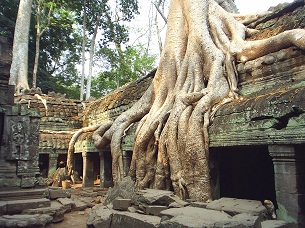Cambodia: Labor standoff at Angkor temple
| Publisher | Radio Free Asia |
| Publication Date | 25 January 2013 |
| Cite as | Radio Free Asia, Cambodia: Labor standoff at Angkor temple, 25 January 2013, available at: https://www.refworld.org/docid/511ce44ec.html [accessed 20 May 2023] |
| Disclaimer | This is not a UNHCR publication. UNHCR is not responsible for, nor does it necessarily endorse, its content. Any views expressed are solely those of the author or publisher and do not necessarily reflect those of UNHCR, the United Nations or its Member States. |
2013-01-25
Union trouble brews among the ruins of Cambodia's 'Tomb Raider' temple.
 Tree roots grow over the west corridor of Ta Phrom in Siem Reap. Photo courtesy of Wikipedia
Tree roots grow over the west corridor of Ta Phrom in Siem Reap. Photo courtesy of Wikipedia
Cambodian authorities have barred 170 workers involved in restoration work on a temple in the world-renowned Angkor historical site from entering the complex after they threatened to strike over planned job cuts, union members said.
The workers, who were restoring the Ta Phrom temple ruins, one of the country's tourist treasures, were prevented by police from entering the site when they showed up to work on Thursday morning, workers' union leader El Saratt said.
They had protested a decision by Indian and Cambodian managers of the preservation project to fire 30 workers and threatened to go on strike unless the jobs were saved.
"We told the project manager that they can't fire the 30 workers, and if they want to fire them then they will have to fire all the workers," El Saratt told RFA's Khmer Service.
"We urge the project to reinstate the workers," he said, adding that the managers have also refused to pay compensation for the workers upon termination.
On Wednesday, the union filed a complaint to Cambodian Ministry of Labor, which has sent the case to an arbitration council.
'Discriminating against the union'
Ta Phrom, known as the "Tomb Raider" temple for the Hollywood movie filmed among its atmospheric ruin, is a UNESCO World Heritage Site that is part of the Angkor Archaeological Park that draws millions of global visitors each year.
Archaeological restoration and preservation in the park is run by the domestic Authority for the Protection and Management of Angkor and the Region of Siem Reap (Apsara) in cooperation with the Archaeological Survey of India, an Indian government institution.
In December, the union had requested ASI and Apsara to give holiday pay and annual wage increases.
Project managers refused to respond to the request, and seven workers were fired shortly afterward.
Deputy union leader Uy Koy said the restoration managers were unhappy with the workers' unionizing and threatening to strike.
"The project manager doesn't like the union and they are discriminating against the union," he said, warning that all the workers would stop coming to work if the union's request to keep the jobs isn't honored.
"We don't want them to use any workers [if they won't keep the 30 fired workers] because if we don't have jobs, we don't have any income."
Work winding down
Devendra Singh Sood, ASI archaeological engineer and head of the Ta Phrom project, refused to comment on the case when contacted by RFA, saying that only officials at the Indian Embassy and in the Cambodian government had the authority to resolve the dispute.
Provincial Labor Department Director Chan Sokhomchenda said he had asked officials at the Indian Embassy not to allow the workers to be let go.
He said restoration work at the temple was winding down and fewer workers were needed.
Cambodian rights group ADHOC urged ASI and Apsara's Ta Phrom project managers to negotiate with the workers.
The group's Siem Reap provincial coordinator Sous Narin said he had asked the Indian Embassy to organize shifts so that all the workers could keep their jobs.
"I have informed the embassy about the labor law," he said.
Tourism is a key pillar of Cambodia's economy and the ruins at Angkor, former capital of the Khmer kingdom, are the country's star attraction.
The Angkor area reeled in 2.06 million foreign tourists last year, with the most coming from South Korea, Vietnam, China, Japan, and Thailand, according to a recent report by the Siem Reap provincial tourism department.
Reported by RFA's Khmer Service. Translated by Samean Yun. Written in English by Rachel Vandenbrink.
Link to original story on RFA website
